resurrection
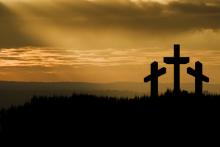
“Liturgical celebration is a re-entrance of the Church into the event, and this means not merely its ‘idea,’ but its living and concrete reality.”
—Fr. Alexander Schmemann
You and I bring our life experiences with us when we gather with other Christ followers for worship. Everything that has happened to us on our pilgrimage in this world accompanies us, in fact, wherever we go.
Our past is part of what makes us unique persons. What we have endured and felt and accomplished informs our conversations and often helps determines our actions in the present moment. This is what it means to be human.
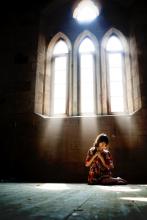
HOW SHALL WE engage with scripture through all 50 days of Easter? There are clues in the haunting story of Jesus' appearance beside the sea of Tiberius. After Easter Day many of us are ready to let things quickly revert to normal. It is, strangely, both reassuring and uncomfortable to hear that those disciples, whose business had been fishing, wanted to get back to their boats so promptly after the horrors and wonders they had witnessed in Jerusalem.
Jesus is waiting for them by the shore with breakfast already cooking. All is ready, yet he wants them to bring some of what they haul up in their nets, so he can include samples of their own catch in the menu. And what a catch it was!
Easter is our time to experience the grace that is always ahead of our game and is underway for us before we are ready. Yet grace does not exclude what we bring to the table. Grace expects and includes the work of our hands, the weavings of our imaginations, and the gifts of our unique experiences. In one sense, Eastertide is more truly a season of repentance than is Lent. One thing we might need to repent of is our passivity—those times when we expect God to hand us on a plate the meaning we are hungry for. We need to bring our own bits to the cooking fire if we are to really eat with Jesus. It is part of the mix of grace that we must participate, not just receive.

FROM THE RIVER to the rope. From the creek to the cross. From the dove and a "voice from above" to death by state execution and profound silence.
This is Lent. This is the Jesus Road, the Christian way. O Lord, how can we follow you?
Lent is time of remembering ourselves. In the ancient church, those preparing for baptism were publicly challenged: Do you renounce your bondage to Master Satan? Do you reject the slave-mind and all its glamour and subtle temptations? Will you allow Christ to buy your freedom?
The catechumen turned to face the east and the dawn, answering: "I give myself up to thee, O Christ, to be ruled by thy precepts."
It is Lent. We go down to the river to pray. We step into the waters of repentance. We surface as a new creature in Christ. From that moment onward, we imprint on Jesus. This is our survival strategy as newborn disciples. We follow him, like ducklings behind their mother.
After his baptism in the Jordan River, Jesus is driven straight out—into the unloved places, into the wilderness. There he is pricked by demons to toughen him up. He is being prepared. He must look into his own despair. Satan is the supreme surgeon for separating us from our hope.

WE WERE LOOKING at cathedrals while others were mourning and burying their dead.
It was the first day of the international design competition that would help choose a few architectural plans that might be used to rebuild Notre Dame de l'Assomption, Our Lady of the Assumption, Port-au-Prince's most famous cathedral. This cathedral was so central to the city that, before it was leveled in the Jan. 12, 2010, earthquake, its turrets could be seen from most places in Port-au-Prince, as well as from the sea, where mariners used a light on the cupola of the church's north tower to help bring their ships home.
During the 2010 earthquake, the Catholic archbishop of Port-au-Prince, Monsignor Joseph Serge Miot, was killed inside an administrative building adjoining the cathedral, along with priests and parishioners. It was the images of their crushed bodies and their loved ones wailing around the perimeters of the cathedral's rubble that motivated me, a non-architect and non-Catholic—but a lover of cathedrals—to agree to join a development strategist, a preservationist architect, a structural engineer, a priest and liturgical consultant, the dean and associate dean of two architectural schools, and the editor of a magazine that discusses the dual issues of faith and architecture to help select three out of the 134 moving, elegant, and in some cases totally out-there designs that we had received from architects all over the world. Among the panelists, three of us were Haitian born, and many of the others had either worked in Haiti or in the Catholic Church for years.
The selection exercise itself was one that mirrored faith, blind faith. We were looking at sketches and plans but had no idea who had designed them. Some of the entries contained written statements that were so moving in their optimism for Port-au-Prince and its 3 million inhabitants, their hopes for Haiti and her people, and their longing for the rebuilt cathedral to serve as a symbol of renewal that they nearly brought me to tears.
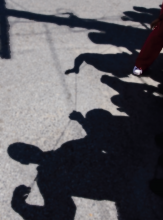
Blindfolded and gagged, tossed in the back
of a car—it's how they gather up young men
and after tire irons and chains, leave some
lying in the road like dirt, rained on all night.
Some are bundled-up, tossed off a bridge
into the river whose muddy swirls warn:
kick, fight, breathe, twist your arms free.
Some do. They rise, spit out the rags
stuffed in their mouths, limp back to town,
and one begins to sing—slow at first— Lord,
I want to be in that number ... Another moans
a low muted tone where words won't go.

IN THE EARLY weeks of the Eastertide lectionary, there appears a series of texts from the third and fourth chapters of Acts ... Peter and John, on their way to temple prayers, heal a man begging at the beautiful gate. His joy begets a sermon from Peter on the resurrection, at the close of which the disciples are arrested and spend the night in jail. The next day in court they again testify boldly, refuse to comply with the court's order, and are released after calculated threats from the authorities. Their release prompts prayers of thanksgiving in the community.
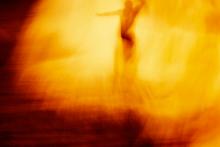
I awoke in the middle of the night last evening and walked the house in the dark. Kenneth and Caitlin were still stirring, as the older children sometimes do on the weekend. As I climbed the stairs back to our room I felt a wave of gratitude.
Here we are all under one roof for who knows how much longer, yet such a privilege to still be together even as four of seven attend college and work hard and make us proud as they figure out what's next.
I got back into bed and Debbie put her arm around me in her sleep. I said "I love you," and she whispered, half-asleep "I love you, too," and for that moment all was well, and I had a sense that all would be well in the future, come what may.
As I lay there in the stillness, an encounter from five years ago came back to me in vivid color. I had just preached the funeral of a man taken unexpectedly following a routine surgery. I was at the wake afterward and sat next to an unassuming man in his mid-50s whose suit was impeccable and whose polite manners suggested a quiet grace and a bearing of humility in his obvious accomplishments, but also a bit of world-weariness.

"THIS IS THE LORD'S DOING; it is marvelous in our eyes. On this day the Lord has acted; we will rejoice in and be glad in it." We will be singing these words from Psalm 118 on Easter Sunday, and they pinpoint a critical issue in our religious witness. Do we have the courage to have God be the subject of sentences, or is God usually the object of our reflections? There is a difference. Do we make ourselves really the subject of our sentences, so that religion is about our doings and ideas and needs? The scriptures insistently talk about what God did and is doing and will do in Christ, the crucified and risen one. Our role is to rejoice in the way God acts upon us, with us, around us, behind us, above us, ahead of us, through us.
Praise is the litmus test. If God is experienced as the one who is acting, the impulse to praise is inevitable. This may help us understand the importance of the psalms in our lectionary. They aren't mere supplementary devotions. As supreme words of praise, they test the authenticity of our reactions to the good news. They test and they can train. The psalter is the church's manual to help practice the "scales of rejoicing," to borrow a phrase from W.H. Auden's "Christmas Oratorio." A phrase on Auden's tombstone comes back to me: "In the prison of his days / Teach the free man how to praise." The psalms come to life only where this teaching is taken seriously.

IN THE TITLE song of Aimee Wilson's new album, Unto Us the Sun, the music begins soft and gentle, like a slight shaft of light breaking over the morning horizon. Gradually the song intensifies, both instrumentally and vocally, until it reaches an almost ecstatic crescendo—a musical embodiment of the process she lyrically portrays of the subtleties of nature opening up its unspeakable beauty, a grand chorus of creation praising its Creator. It is also hardly incidental that the song evokes biblical language of resurrection, while both the title and images such as "tender as the shoot" subtly hint at the presence of Christ—not a heavy-handed doctrinal Christ, but the saving incarnation of a loving God.
Wilson is part of a remarkable network of young, spiritually rooted musicians (such as the Psalters) who are fashioning a very new and dynamic musical language of radical faith—a faith that is searching, exploring the edges of experience, probing human hurts and joys as well as divine mysteries and manifestations. Wilson's personal journey has taken her from the hills of her native Tennessee to inner-city Philadelphia. Her songs cover a range of moods, many reflecting her mystical apprehension of God's presence in creation. Other songs, drawing on her experience working with women who have struggled with homelessness and mental illness, convey the power of grace amid human brokenness.
ECONOMIC DEVELOPMENT advocate Angela Glover Blackwell makes no bones about why PolicyLink, the nonprofit she leads, held its 2,500-person Equity Summit in Detroit last November: “Detroit represented the problem and the hope.”
It’s the problem because it’s “a classic example of what happens when you don’t keep up with the needs of a changing population.” It’s the hope because it’s a hub of fresh energy—from government, foundations, community groups, and business—aiming to “build a future based on the people who are going to be the future.”
When Blackwell talks about that future, she means one founded on the people who live in Detroit now, “not some imaginary people who aren’t here—and not based on trying to attract people who have decided they don’t want to be here.” Over the last half century, fewer and fewer white people have decided to live in Detroit. This trend started in the mid-20th century as more and more people of color did live there, and continued over the last three decades as many people of color also started to move away. In the 2010 census, Detroit registered at just over 700,000 people, down from 1.2 million in 1980. Those that remain face a stark economic situation: 34.5 percent live below the poverty level, Blackwell points out, compared to 15 percent nationally.
For many, Detroit is not just the epitome of the Rust Belt, but of a black-and-white narrative that is so rote as to seem invisible, or invincible: Whites flee an urban area, African Americans in poverty remain (more than 80 percent of Detroit’s 2010 population was African American). But for Blackwell, the story and statistics are never just black and white. She points out that, in Detroit, poverty includes not just 37 percent of African Americans, but also “32.5 percent of Latinos, 33 percent of whites—because so many white people who live in Detroit have been left behind—and 47 percent of Asians; that represents a concentration of the Hmong population.”
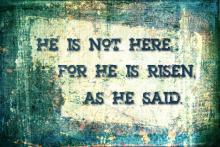
Yesterday the Lord Awoke.
You see, God had been sleeping. Entombed again. How long, O Lord, must we sing this song of You Entombed? We bury you again and again. We crucify you again and again. Then, when you show us (again and again) that death cannot contain you, we run away. We're afraid. We cannot imagine a world in which Death has no sting. We cannot imagine a world in which Death does not hold the last word and our ability to deal in Death doesn't empower us.
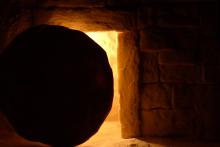
The Gospel of St. Matthew, Chapter 28 tells us:
The angel spoke to the women: "There is nothing to fear here. I know you're looking for Jesus, the One they nailed to the cross. He is not here. He was raised, just as he said. Come and look at the place where he was placed.
"Now, get on your way quickly and tell his disciples, 'He is risen from the dead. He is going on ahead of you to Galilee. You will see him there.' That's the message."
To listen to a playlist of music for this Resurrection Day 2012, CLICK HERE.
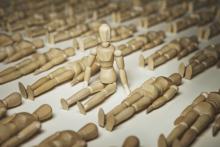
Poetry is language made material.
It presents us with objects and the world, yes, that is part of its materiality, but it also – and perhaps fundamentally – makes our very language into a thing, rather than simply a medium. Like remembering that you exist in time, and becoming aware of your temporality, poetry takes what we are always immersed in and says, Remember; become aware.
Thus it is like all art a meditative practice. You must slow down, quiet yourself, and actively receive – a strange gesture, perhaps paradoxical, but one that is, if nothing else, prayer. And so for Holy Week, I want to present four (mostly) contemporary poems that can direct meditation without limiting it, that can engage prayer in our physical existence and the existence of the Resurrection as event, that can slow one down, that can build sensual memory of the acts we do and life we live in constant remembrance of it, of Him.
It had been more than a week since the doctors had moved me into the ICU, and more than a week since I had tasted anything liquid.
My tongue was dry and felt like leather. At night, I would watch the machines around me blink. The IV bags hung next my bed and scattered the light across sterile white walls.
 I tried not to cry when I could no longer control my bowels. I lay there in my own filth waiting for a nurse to rescue me.
I tried not to cry when I could no longer control my bowels. I lay there in my own filth waiting for a nurse to rescue me.
I came into the world unable even to clean myself and now it seemed I would leave it in the same state.
Finally the nurse arrived to help me.
“I’m thirsty,” I told her. “May I have an ice cube?”
She said no.
“Please? My mouth is so dry. Just an ice cube,” I begged.
“No.”
Oxygen tubes inserted into my nostrils had rubbed my nose raw. I pulled them out.
I felt relief. I watched the numbers drop on the LCD screen. An alarm sounded.
I tried to put the tubes back when the nurse ran in.
“Mr. King, you need the oxygen,” she chided, skillfully replacing al the tubes and checking all the machines and medicines that flanked my hospital bed — all the things that were keeping me alive.
In this segment from his new CatholicTV series "Blinks," the Rev. Jim Martin (aka our favorite Jesuit) considers why Christianity is often considered so joyless, and why "religious" usually means serious.
Watch inside...
Last week, 2001 cases were resolved — many were dropped and others left offenders with minor fines. People who showed up to the event also received resources and assistance for services related to health, housing, employment, and education.
While the program is not explicitly religious, church and clergy involvement shed light on the Christian spirit of the initiative. Project Safe Surrender is not quite Jubilee— offenders aren’t guaranteed amnesty — but there is a taste of the Resurrection.
There's something special about the bookends of our lifetimes. I became a first-time father seven months ago and a hospice chaplain just one month past. Growing up and growing old, especially the first and last months of our lives, can be surprisingly similar experiences.
I fed my daughter sweet potatoes for the first time last night. Introducing her to solid foods has been a treat. While we're trying our best to teach her the sign language words for "food", "more", and " all done", Robin still finds closed-mouth grumble-whines to be the best way to let us know she thinks sweet potatoes aren't all that hot. Another subtly nuanced whine might instead wonder, "You don't happen to have any more mashed banana or applesauce around, would you?" My attempt to turn the filled spoon into an acrobatic and roaring airplane met with scant success.